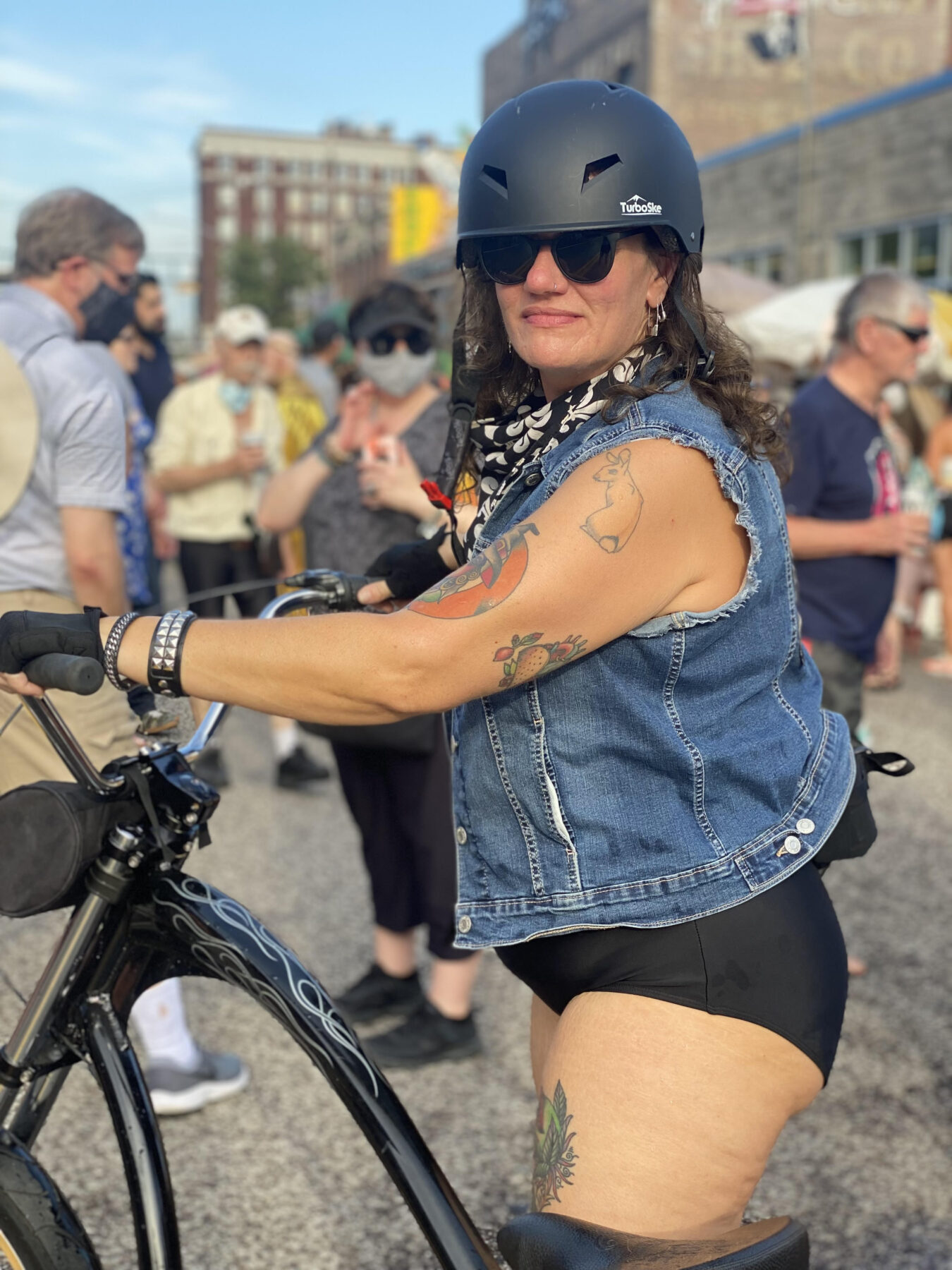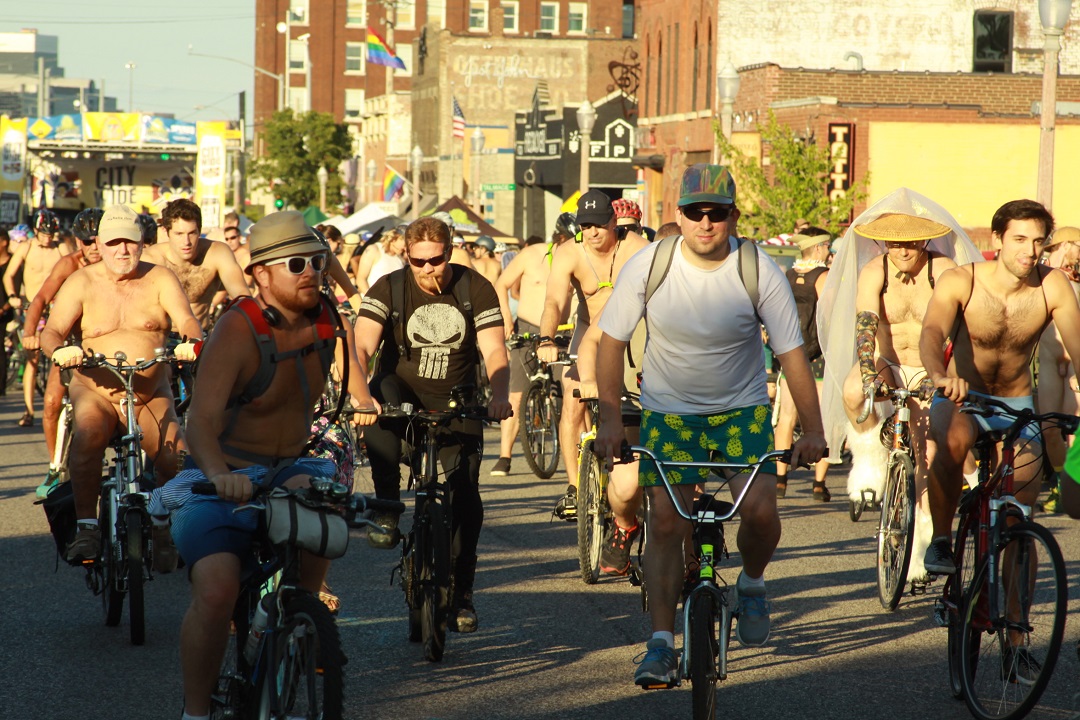Growing up in Russia and St. Louis, Tatyana Telnikova had “so much anxiety about the way I looked,” she said.
But when Telnikova, who has always been in good shape, would express her insecurity to people, they would say, “What are you talking about? You have a nice body.’”
“But you don’t feel that way,” she said.
To counteract those common misgivings, Telnikova, the owner of the HandleBar in The Grove, organizes the World Naked Bike Ride each year in St. Louis. The event provides an opportunity to ditch the restrictive bike shorts and protest “against oil dependence, and for cyclist safety and body positivity,” according to the event website.
Riders, not all of them nude, also often use their bodies and bikes as poster boards for a variety of causes. The St. Louis iteration of an event that happens around the world started with about 300 riders in 2008 and has grown to become a party featuring almost 3,000 riders.
“I think a lot of the people’s self-confidence and the way they present themselves in the world comes from how they feel in their own body,” said Telnikova, who has participated since 2009. “If you can make someone feel good about how they look, no matter what they look like, I feel like even if it’s for one day, one night, I think that it can have an impact.”
Event Origin
People trace the origins of the event to Conrad Schmidt, an activist and filmmaker who rode naked in 2003 in Vancouver, British Columbia. He also founded the Work Less Party, whose primary aim was shifting to a 32-hour work week.
“Organizer Conrad Schmidt said he hoped the group’s nakedness wouldn’t overshadow its message, contending that the United States’ dependency on Middle Eastern oil is the true driving force behind a war with Iraq,” the Associated Press (AP) reported. “The group also called for the city to adopt less fuel-reliant lifestyles.”
“Otherwise, we’re going to go into oily war after oily war,” Schmidt told the AP.
The ride became an annual event in cities around the world, including Madrid, London, and Madison, Wisconsin.
Telnikova became involved when an organizer approached her about moving the ride’s finish line from South Grand to The Grove. Telnikova and the owner of Atomic Cowboy closed a side street and set up a stage.
“It very quickly outgrew the street,” said Telnikova, who took over the ride in 20xx and moved the launch point for the ride to The Grove and started to shut down more of the street for the afterparty.
Reasons to Ride
Andrea Hitsman, an event planner at a local university, started participating in the ride in 2015. She sees the event as an opportunity to promote body positivity because “it’s just one day where folks can wear whatever they want,” she said.

Andrea Hitsman.
“People just can kind of come out and express themselves, and it’s a judgment-free zone for that day,” said Hitsman, who serves on the ride planning committee and helped with an effort to ensure that people asked for consent before taking photos of riders.
Hitsman also organizes the BICI RIDE, “a casual cycling club for social deviants.” She sees the naked ride as an effective way to promote cycling safety. Each year, she sees a nude rider who writes, “Do you see me now?” on his back.
“His messaging is for motorists to keep an eye out” for cyclists, she said.
Matt Wyczalkowski, a data scientist in cancer genomics, is a lifelong cyclist and says the ride is “almost like being a fish in a school, just the whole group moves together, and it’s almost like flying.”
That experience makes people want to ride around the city on other occasions, Wyczalkowski said.
“It serves as a demonstration and a model for being able to explore the city,” he said. “If they do it once, then they might be more comfortable to do it again.”
Criticism and Acceptance
Despite its positive impact, the ride is not immune to criticism. In 2019, its organizers received feedback that the ride had few people of color and that because it was predominantly white, they were able to ride naked without worrying about breaking any laws, Hitsman said.
“We did try to get the word out to expand the community,” said Hitsman. Even though it started as a protest against Big Oil, the ride has turned into an event aimed at building “body positivity and a community of acceptance.”
Telnikova says she also has struggled with whether the ride actually furthers its original cause of breaking society’s dependence on fossil fuels.
“We have people driving in to do this ride all the time,” she said. “How does it make a difference in oil dependency? I don’t know how.”
Still, for Telnikova and others, the ride’s benefits outweigh any imperfections.
“I can’t tell you how many times I’ve met people at the bar, and they’re like, ‘Oh, I would like to ride my bike, but how would I even do that in the city? You know, it’s just so unsafe.’” Telnikova said. “And you’re like, ‘Oh, well, why don’t you come on one of our bike rides and we’ll show you how?’”
Author: Eric Berger is a regular contributor to Terrain Magazine.
Top Image: The St. Louis Worl Naked Bike Ride in 2017. (Rikk Brummet)


[…] Terrain Magazine traced the origins of the World Naked Bike Ride to Conrad Schmidt, an activist and filmmaker who rode naked in 2003 in Vancouver, British Columbia. […]